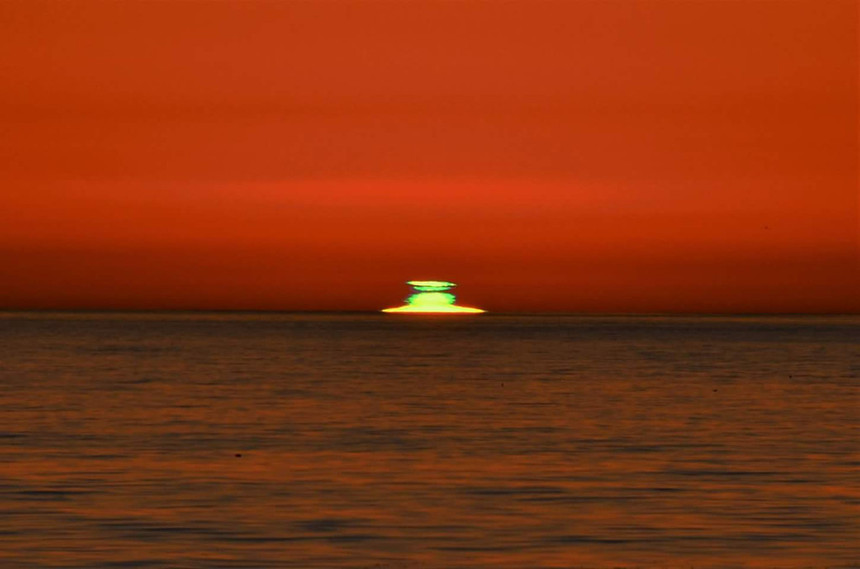
Among the variety of optical phenomena with which nature periodically presents us, there is one that can cause true awe and admiration. We are talking with you about the green ray.
It is an extremely rare phenomenon, which only adds to its uniqueness and makes photographers, and simply those who try to be happy, look for an encounter with it. And how could it be otherwise, because according to an ancient Scottish legend, the man who sees a green ray of the setting sun, will be incredibly lucky and surrounded by love.
By the way, the inhabitants of other seaside countries, who happened to see a green ray, ascribed magical properties to it. The Pirates of the Caribbean even believed that the appearance of green glow symbolizes the return of the souls of pirates from the world of the dead. And those who never got a chance to see it, called all the stories about it fiction, or optical illusion. But is it true?
Perhaps the "green ray" was considered a hoax because for a long time no one was able to photograph or film this amazing phenomenon. Today we are already convinced of its existence and can observe numerous images of the "green ray" in photos and video, and especially the inquisitive have a chance to see it for real.
So, what is the "green ray" and where can it be seen? According to experts, the "green ra y" is an unusual natural phenomenon, which can sometimes be observed at the time of the final disappearance of the sun behind the horizon or its emergence from behind the horizon. In fact, it is just a brief flash, a column of green light rushing into the sky.
How to see a "green ray"?
Practice shows that to observe the "green ray" three conditions must be met. You need an open straight horizon (calm sea, tundra or steppe), clear air, and no clouds or clouds.
Most often, this green flash is observed in the sea, during the full calm. And there is nothing surprising about it. It turns out that with the naked eye the "green ray" is simply impossible to see. It is necessary to have binoculars, telescope or telescope. And since seafarers most often have such items, is it any wonder that this natural phenomenon is more often identified with the sea?

By the way, if you want, the "green ray" can be seen almost any day, the main thing is not to interfere with your view. It is enough to point a suitable magnifying device to the horizon line and wait. True, there is one nuance. It is dangerous to look at the descending celestial body for a long time. The bright light of the setting sun can burn the retina. Therefore, it is necessary to "catch" the "green ray.
And to catch it is not easy, because this natural phenomenon lasts no more than 2-3 seconds. However, some observers were able to significantly increase the time of observation of the beam. For this purpose, at the moment of the appearance of the "green ray" they quickly moved along the embankment, keeping the position of the eye relative to the beam, i.e. in fact they moved behind it.

Surprisingly, but during the expedition to the South Pole, the American explorer Richard Baird observed the "green ray" for more than half an hour! He was able to do this because it took place just before the end of the polar night, when the solar disk rose above the horizon extremely slowly, moving along the edge for a long time.
Where does the green glow come from?
And here a legitimate question arises: where does the pleasant green glow come from when the Sun is usually yellow, orange, or red?
It's actually understandable if you remember the physics course. When the Sun is at its zenith, it casts scattered rays on the Earth, which combine to form one white light. But at sunset, when
solar disk disappears and the last ray remains, it is refracted in the atmosphere, splitting into a spectrum of seven colors (the same colors that form the rainbow after the rain).
But we don't see the whole spectrum. The last color of the spectrum is violet. In principle, that's what we're supposed to see. But it is too short, as well as blue, so both of them are scattered in the atmosphere. Red and yellow are absorbed by the ice fog from the lower layers of the atmosphere. This is why only the green beam remains visible to the eye. When the Sun rises, however, the opposite sequence is observed, which means that we can also observe a "green ray" before the Sun's disk appears.
This phenomenon was described in detail by the famous scientist Yakov Perelman in his book "Amusing Physics". The French writer Jules Verne has a novel "The Green Ray". In it, the heroine of the novel learns about this mystery of nature and goes on a long journey to see a "green ray" for once.
What is characteristic, this amazing natural phenomenon can take many forms. Most often, observers see a semicircle formed by the edge of the solar disk. Sometimes only the green segment is visible. But the rarest is considered a real green ray or green column, bursting into the sky from behind the horizon. As a rule, this is what photographers "hunt" for.



Comments ('0')
Discuss